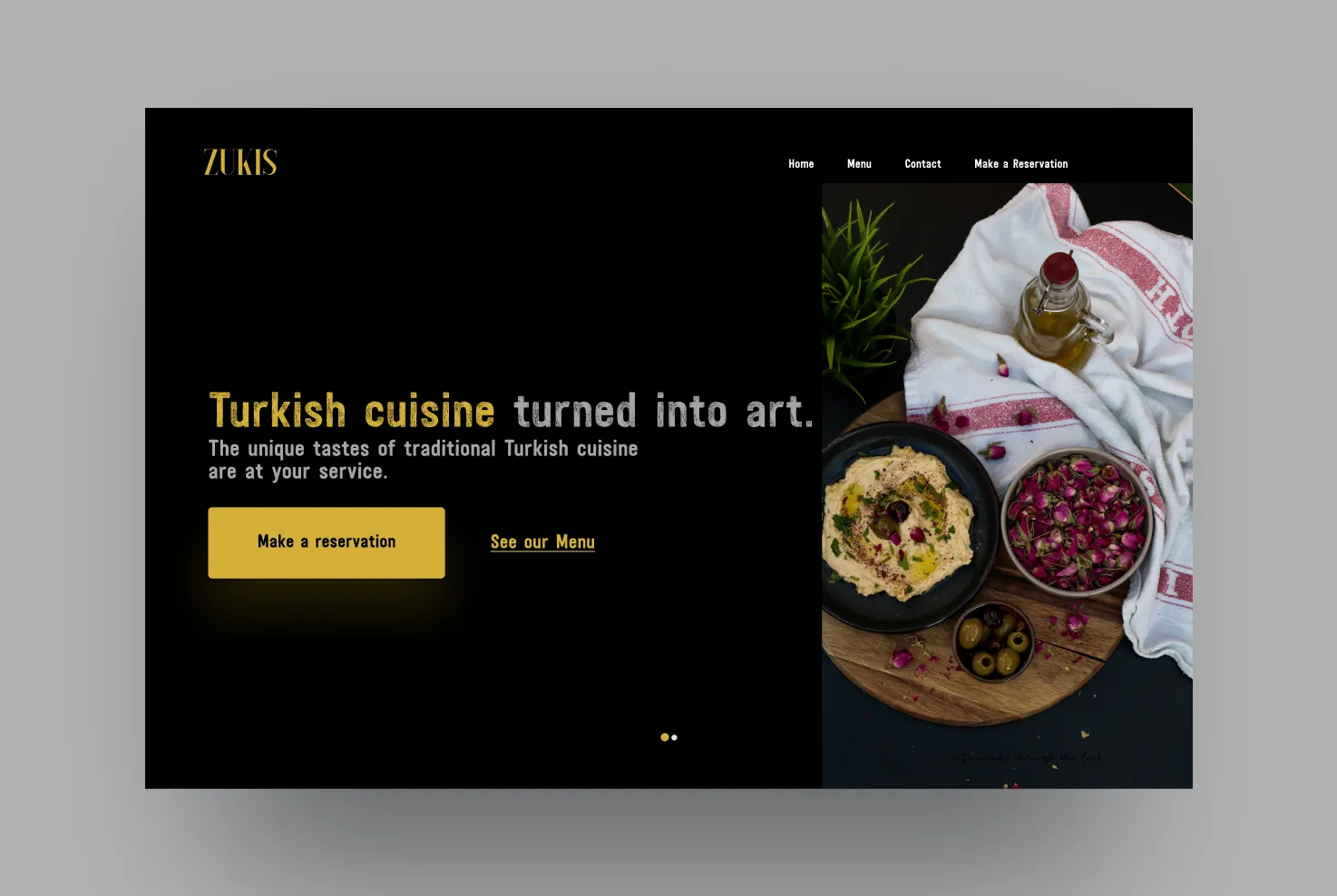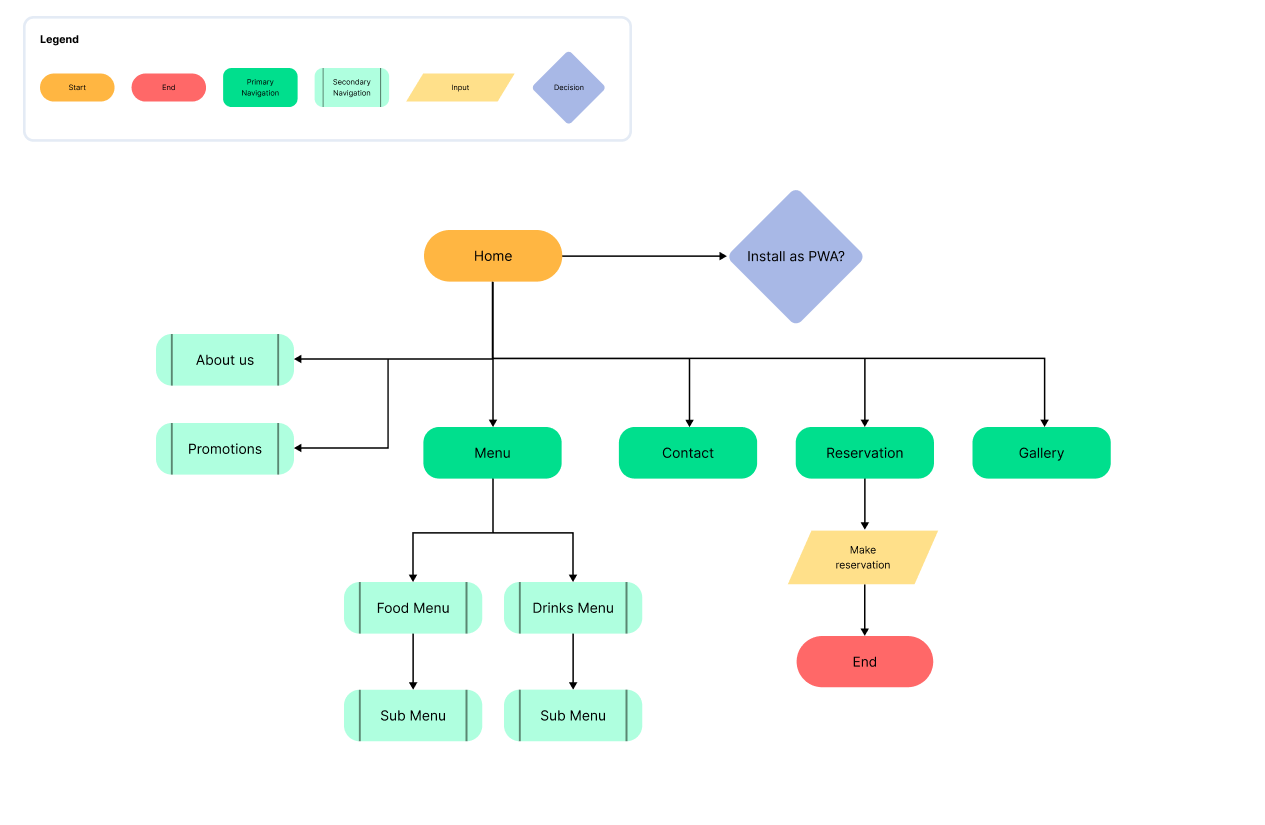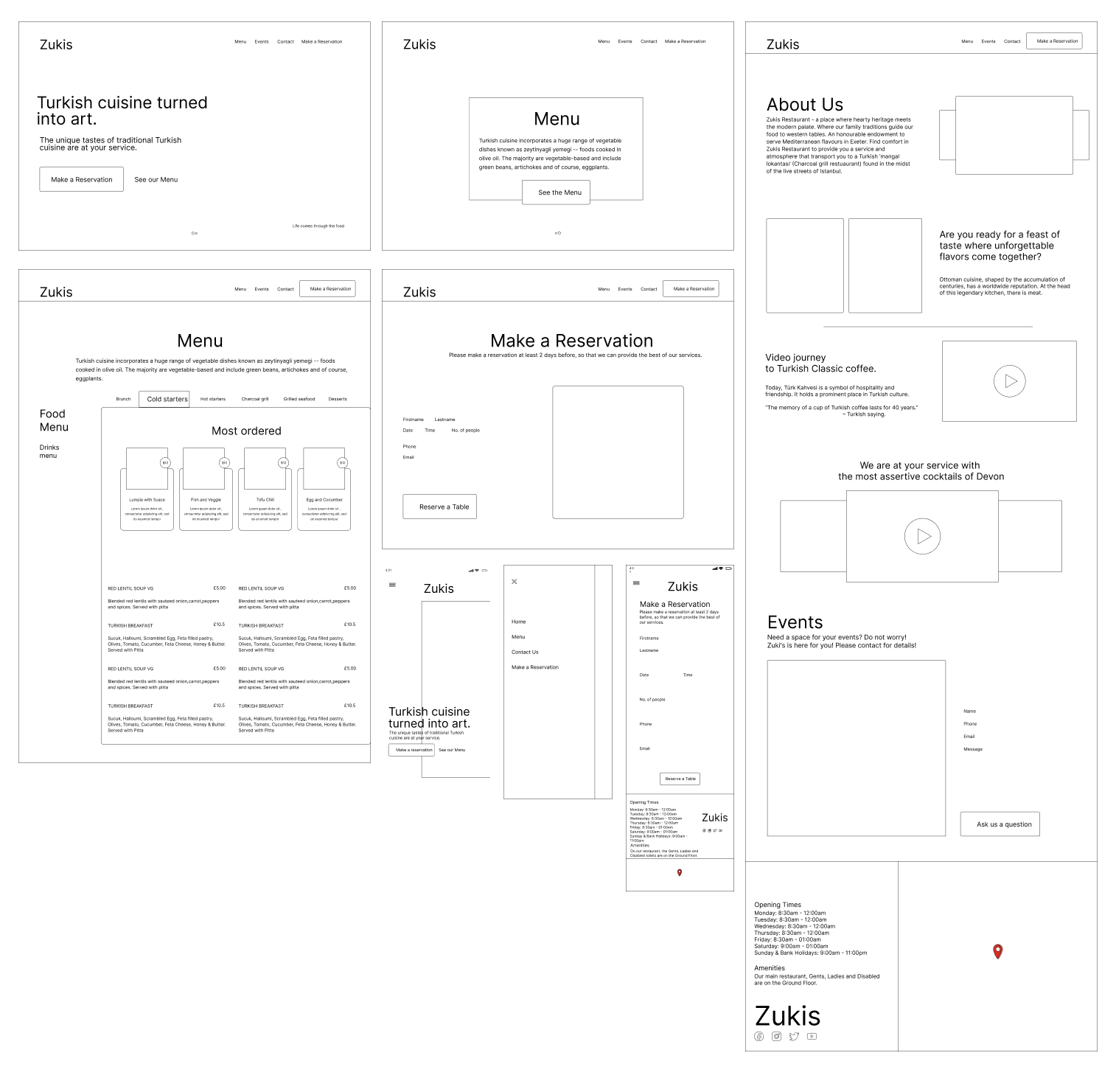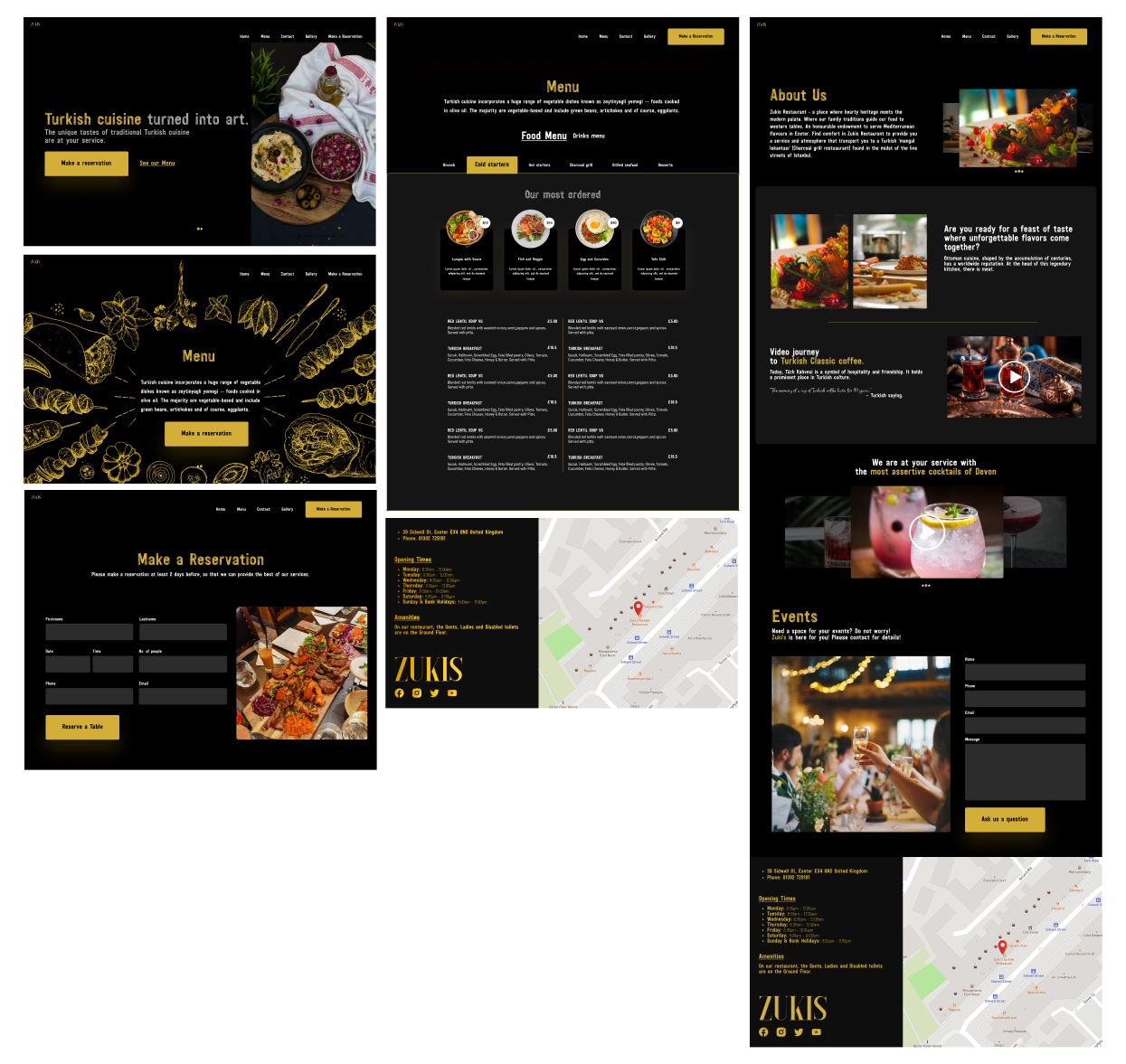
Zukis is a modern restaurant that required a fast and efficient online presence to attract customers and facilitate reservations seamlessly.
The website’s optimization led to a top 2 ranking on Google, significantly boosting the restaurant’s customer base.
Role: Responsible for the entire project, handling UI/UX design, web development, server management, SEO, and email automation.
Tools: Figma, Firebase, React Js, Twilio SendGrid, Google Analytics, Microsoft Clarity
The website’s optimization led to a top 2 ranking on Google, significantly boosting the restaurant’s customer base.
Role: Responsible for the entire project, handling UI/UX design, web development, server management, SEO, and email automation.
Tools: Figma, Firebase, React Js, Twilio SendGrid, Google Analytics, Microsoft Clarity
Challenges
The client required the website within 3 weeks. So I had to prioritise gathering requirements and conducting the user research as quickly as possible.
Goals
- The goal was to create an engaging and responsive website with a robust reservation system.
- Ensure high visibility on search engines and increasing foot traffic to the restaurant.
Methodologies
1. Competitive analysis
2. User survey
2. User survey
UX Research and Insights
Competitive Analysis
Competitive analysis aimed to identify industry best practices, design trends, and functionality benchmarks for restaurant websites. The findings helped inform the development of Zukis website, ensuring it not only met but exceeded user expectations while staying competitive in the restaurant industry.
I selected five top-performing restaurant websites based on search engine rankings and user reviews in the local markets.
I selected five top-performing restaurant websites based on search engine rankings and user reviews in the local markets.
Evaluation criteria
- User experience (UX):
Navigation structure, mobile responsiveness, and ease of use. - Visual design:
Branding consistency, use of imagery, and aesthetic appeal. - Features and functionality:
Reservation systems, menu layouts, special offers, and integration with email or notification systems. - SEO strategies:
Keyword usage, meta tags, image alt texts, and page loading speeds. - Performance:
Site speed, uptime, and responsiveness on mobile and desktop.
User Survey
The objective was to gather quantitative insights about potential users’ preferences, frustrations, and expectations from a restaurant website, focusing on features like reservations, menu accessibility, and ease of use.
Process
I created a concise, 10-question survey using Google Forms to ensure broad participation. The questions were a mix of multiple-choice and open-ended types, covering:
- Preferences for making online reservations.
- Importance of mobile responsiveness and design aesthetics.
- Frustrations with existing restaurant websites.
Target audience
- I distributed the survey via social media, targeting urban diners aged 25–45, frequent restaurant-goers, and people who prefer online bookings.
- I collected 50 responses to provide statistically significant insights.
Impact on the design
- Prioritized mobile-first development and fast-loading pages.
- Implemented a clean, intuitive interface for navigation and reservations.
UX Design Process
Product Goals
After gathering key insights from user survey and competitive analysis, I outlined the website goals.

Information Architecture
Since faster loading times and simple interface were a priority, I decided to create a single page application.

Idea & Wireframes
Wireframes
I created low-fidelity wireframes to visualize screen layouts. The main pages were designed in figma, iterating based on team feedback and usability principles.
I created low-fidelity wireframes to visualize screen layouts. The main pages were designed in figma, iterating based on team feedback and usability principles.

UI Design
Design principles
I developed a clean and visually appealing layout that showcased the restaurant’s ambiance, brand colors and menu. Key design elements included: Key components
Key components
Users may visit a restaurant website and when looking at the menu, will be displayed a pdf. This makes it harder for them to find out what they are looking for.
One of the key differences from our competitors is the easy menu navigation.
I developed a clean and visually appealing layout that showcased the restaurant’s ambiance, brand colors and menu. Key design elements included:
- Home page: Highlighting featured dishes, location, and reservation call-to-action.
- Reservation system: A user-friendly form allowing customers to reserve effortlessly.
- Menu section: An easy-to-navigate layout displaying the full menu.

Users may visit a restaurant website and when looking at the menu, will be displayed a pdf. This makes it harder for them to find out what they are looking for.
One of the key differences from our competitors is the easy menu navigation.
Development & Testing
1. Understanding the Requirements
Since the project began with an in-depth consultation with the client to define objectives and user expectations, clear priorities were set with realistic goals for the development:
- A fast, scalable website with seamless navigation.
- A highly responsive design to cater to both desktop and mobile users.
- An efficient reservation system with real-time updates.
- Search engine optimization (SEO) to increase visibility and attract more customers.
I outlined the features and tools required, and I made sure that the chosen stack (React.js, Firebase, Twilio, PWA standards) aligned with the client's goals and project timeframe.
I used tools like Google Lighthouse and PageSpeed Insights to set performance benchmarks, which helped me form decisions about PWA integration and backend architecture.
I used tools like Google Lighthouse and PageSpeed Insights to set performance benchmarks, which helped me form decisions about PWA integration and backend architecture.
2. Development & UI/UX Implementation
I developed the UI using React Js, ensuring reusable components for scalability and maintainability. The development process were mainly focused on:
Home page
Eye-catching visuals, prominent call-to-action (CTA) buttons, and key details about the restaurant.Menu pageA clean, filterable interface allowing users to explore dishes based on categories.
Progressive Web App integration:
- Offline functionality to browse the menu.
- Add-to-home-screen functionality to improve user retention and accessibility.Reservation system
A visually appealing yet simple form with clear input validation and real-time feedback.
Reservation System Development
The reservation system was designed to simplify the booking process for customers while providing restaurant staff with an easy way to manage reservations. This system has the following key features:
- Dynamic Form for Booking:
- Customers could select their desired date, time, and party size.
- Input fields included live validation for smooth user interaction. - Table Allocation Based on Party Size:
- Instead of assigning specific tables, the system collected the number of people in the party.
- Restaurant staff used this data to manage table arrangements efficiently. - Automated Confirmation:
- Twilio SendGrid API was used to send immediate reservation confirmation emails to customers. These emails included booking details such as the time and date, ensuring a reliable experience. - Admin Dashboard:
- A simple interface for restaurant staff to view, filter, and manage reservations.
- Staff could see the number of guests for each time slot and allocate tables accordingly.
By focusing on flexibility, this approach allowed the restaurant to optimize seating arrangements dynamically, ensuring maximum efficiency during peak hours.
Progressive Web App (PWA)
To enhance user accessibility and engagement, I transformed the website into a Progressive Web App (PWA), offering app-like features without requiring a traditional app download.
I implemented service workers for offline caching of static assets (menu, homepage), providing a smooth experience and fast load times on repeat visits.
I also optimized images and dynamic content caching to enhance performance and reliability.
This allowed users to save the app to their device's home screen for quick access, mimicking a native app experience. It resulted in significantly improved user retention and customer satisfaction, especially among mobile users who appreciated the offline capabilities and quick accessibility.
I implemented service workers for offline caching of static assets (menu, homepage), providing a smooth experience and fast load times on repeat visits.
I also optimized images and dynamic content caching to enhance performance and reliability.
This allowed users to save the app to their device's home screen for quick access, mimicking a native app experience. It resulted in significantly improved user retention and customer satisfaction, especially among mobile users who appreciated the offline capabilities and quick accessibility.
3. Server Management
The backend was powered by Firebase, chosen for its scalability, real-time data capabilities, and serverless architecture. Some of key features used in this project are:
Real-time updates:
Reservations were updated instantly across the website and admin dashboard.
Cloud functions:
Used Firebase Cloud Functions to handle automated tasks, such as sending confirmation emails and performing periodic database cleanups.
Security rules:
Applied Firebase’s security rules to restrict access to sensitive data and prevent unauthorized actions.
Real-time updates:
Reservations were updated instantly across the website and admin dashboard.
Cloud functions:
Used Firebase Cloud Functions to handle automated tasks, such as sending confirmation emails and performing periodic database cleanups.
Security rules:
Applied Firebase’s security rules to restrict access to sensitive data and prevent unauthorized actions.
4. Search Engine Optimization
To maximize visibility and attract more customers, I implemented awell-structured SEO strategy. The goal was to ensure that Zukis website not only ranked highly on Google but also provided users with valuable and relevant content. The strategies I used for this project are:
- Optimized images, minified CSS/JavaScript, and used lazy loading to reduce page load times.
- Used clean, descriptive URLs to make the site more user- and search-engine-friendly.
- Created keyword optimized alt texts for images, ensuring better performance in image search results.
- Monitored the website’s SEO performance using tools like Google Analytics and Search Console.
- Ensured the site was fully responsive, aligning with Google’s mobile-first indexing policy.
- Optimized page titles, meta descriptions, and headers to include these target keywords naturally, improving search engine relevance.
- Conducted thorough keyword research to identify high-impact terms related to the restaurant.
Outcome
Within weeks of launch, Zukis secured a top 2 position on Google for key search terms, driving substantial organic traffic.
Faster page load times and mobile-friendly design resulted in a lower bounce rate and higher session durations.
The higher visibility and seamless user experience translated directly into increased foot traffic and reservations, contributing to the restaurant’s profitability.
The higher visibility and seamless user experience translated directly into increased foot traffic and reservations, contributing to the restaurant’s profitability.
Key Takeaways
Challenges
Balancing speed and aesthetics:
Ensuring a fast-loading site while maintaining high-quality visuals for showcasing Zukis dishes.
I used lazy loading for non-essential images and optimized image file sizes without compromising quality.
Ensuring a fast-loading site while maintaining high-quality visuals for showcasing Zukis dishes.
I used lazy loading for non-essential images and optimized image file sizes without compromising quality.
Real-time reservation updates:
Building a system to manage real-time reservation data without overcomplicating the process for the staff.
I implemented Firebase for real-time data sync and created a simplified dashboard tailored to staff workflows.
Building a system to manage real-time reservation data without overcomplicating the process for the staff.
I implemented Firebase for real-time data sync and created a simplified dashboard tailored to staff workflows.
Limited development time:
Delivering a fully functional website with robust features within a tight deadline.
Leveraged a modular development approach and reused pre-tested components to speed up the development process.
Delivering a fully functional website with robust features within a tight deadline.
Leveraged a modular development approach and reused pre-tested components to speed up the development process.
SEO competition:
Competing with established restaurants for top-ranking spots on Google.
I focused on local SEO strategies, keyword optimization, and content marketing to improve the website’s visibility.
Competing with established restaurants for top-ranking spots on Google.
I focused on local SEO strategies, keyword optimization, and content marketing to improve the website’s visibility.
Lessons Learned
SEO's impact on business:
A well-optimized website demonstrated how technical and content-driven SEO could directly contribute to increasing visibility, reservations, and revenue.
A well-optimized website demonstrated how technical and content-driven SEO could directly contribute to increasing visibility, reservations, and revenue.
User-centric design:
A mobile-first and intuitive UI/UX approach made it easy for customers to navigate the website and make reservations, significantly improving user engagement.
A mobile-first and intuitive UI/UX approach made it easy for customers to navigate the website and make reservations, significantly improving user engagement.